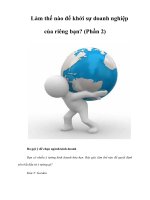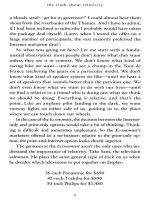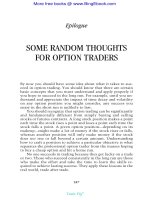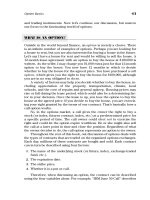The Public Innovator’s Playbook: Nurturing bold ideas in government phần 2 pps
Bạn đang xem bản rút gọn của tài liệu. Xem và tải ngay bản đầy đủ của tài liệu tại đây (602.12 KB, 16 trang )
12
The Public Innovator’s Playbook: Nurturing Bold Ideas in Government
• Dowehavemechanismstoletideas
flow in and out of the organization?
• Dowehavethecapabilitiestoadopt
a particular strategy for innovation?
• Istheorganizationalcultureintune
with the innovation mechanism?
• Istheorganizationalstructurehi-
erarchical and opaque, or does
it offer meaning, flexibility, and
novelty to young entrants?
Some changes in organizational structures
and cultures are necessary to make opti-
mal use of innovation strategies. Emerging
organizational models, such as the networked
approach, require a bigger and more funda-
mental change. In this model, public sector
organizations may no longer own the services
they provide. Instead, they aggregate and
manage services provided by others, gather
ideas from anywhere, and tap talent markets
farandwide.Agenciesthenuseinternalskills
to adapt these ideas to their specific needs.
The future of public sector
innovation
The central idea of this book is to
show how to make innovation more
than an isolated project or special
program in the public sector. For in-
novation to take root, government
agencies will need to take an inte-
grated view of the innovation process,
from idea generation, to selection, to
implementation and diffusion. In ad-
dition, public agencies have to take a
new look at strategies for fostering a culture
of innovation and building an organizational
structure that supports innovation. This entails
developing an organizational culture where
anyone can contribute ideas to help generate
breakthrough innovations. It means creating
organizational structures and systems that
are better and faster at leveraging the creativ-
ity of those closest to the problem, whether
they are employees, partners, or citizens.
Governments cannot be complacent about
theirabilitytoinnovate.Astheexternal
environment changes at an increasingly rapid
pace, an organization’s ability to innovate
becomesmorecrucial.Asthechallengesfacing
government become more important, clos-
ing the innovation gap becomes imperative.
Using multiple innovation approaches helps
overcome weaknesses in the public sector’s
innovation cycle, while the organizational
structure provides the bedrock for the innova-
tion process to work. We begin this discussion
inChapter1withtheinnovationprocess.
13
The Public Innovator’s Playbook: Nurturing Bold Ideas in Government
Introduction
“Innovation— any new idea—by
denition will not be accepted
at rst. It takes repeated
attempts, endless demonstrations,
monotonous rehearsals before
innovation can be accepted and
internalized by an organization.
This requires courageous patience.”
Warren Bennis
The innovation process
“We started from the premise that it is
possible to run an innovation program
in much the same way we run a factory.
There are inputs; these go through
a series of transformative processes,
creating outputs.”
Procter and Gamble CEO, A.G. Laey
TThe Public Innovator’s Playbook: Nurturing Bold Ideas in Government
The
innovation
cycle
C
ontrary to the stereotype, many governments are adept at generating
ideas. Public-private committees, citizen panels, and internal employee
groups all have been used to crank out proposals for improving public sec-
tor operations. Where governments often flounder is putting these propos-
als into practice. In recent years, several governments have launched high-
profile performance reviews, where committees of public and private sector
executives reviewed government practices and suggested reforms. Some of
these initiatives delivered substantive benefits, others faded from view soon
after the final report was released. What was the difference? Successful in-
novators had a plan for turning good proposals into concrete action.
Many governments focus most of their time and resources on idea genera-
tion rather than implementation and diffusion. It is analogous to the weekend
golfer who spends hours at the driving range whacking drive after drive. Once
out on the course, the long practice hours invariably pay off as our hero’s
long, straight drives impress his golfing buddies. Once the scores are tallied,
however, he finds himself dead last. Why? He lacks a short game. He forgets
that the object of the game is to get the ball in the hole and doesn’t focus
onthelittlestuff.Astheprosputit,“Youdriveforshow,puttfordough.”
Inshort,innovationisnotjustaboutgeneratinggoodideas.Agoodideais
only the first step; organizations then need to implement the idea and pro-
duce results. To do that, they need a clear roadmap for converting ideas into
effective solutions that earn the support of stakeholders. This process view of
innovation, the innovation cycle, typically consists of four stages: idea genera-
tion,ideaselection,ideaimplementation,andideadiffusion(gure1.1).
Successful innovators focus on all stages of the innovation cycle. In a re-
cent Harvard Business Review article, professors Morten T. Hansen and
Julian Birkinshaw argue, “When managers target only the strongest links
in the innovation value chain — heeding popular advice for bolstering a
core capability in, say, idea generation or diffusion — they often further
debilitate the weakest parts of the value chain, compromising their inno-
vation capabilities further.”
4
The process outlined in the rest of the chap-
ter can help build strong linkages throughout the innovation cycle.
1
The innovation cycle
17
18
The Public Innovator’s Playbook: Nurturing Bold Ideas in Government
Generation
There tends to be no shortage of ad-
vice in the public sector, with academics,
consultants, policy entrepreneurs, advo-
cacy groups, and opinion leaders propos-
ing innumerable solutions to perceived
problems. Often the proposed ideas con-
flict with one another based on ideologies,
vested interests, and political leanings.
Rather than letting occasional good ideas
from the outside drive the innovation pro-
cess, governments should take control of the
process by developing a system designed to
consistently address the unique challenges
publicagenciesface.Figure1.2refersto
ways in which the four sources of innova-
tion — employees, internal partners, external
partners, and citizens — can be engaged to
systematically generate and capture new ideas.
How many public sector employees get the
opportunity to walk up to their agency heads
with good ideas? Do organizations that supply
goods and services to government work as
partners to deliver integrated public services?
Is there a systematic way of in-sourcing ideas
into the public sector? Collaboration tools like
wikis and blogs make it easier to cross-pollinate
ideas among employees, partners, and citizens.
For instance, employees who were formerly
separated by operational and organizational
silos can now exchange information in Web-
based open forums. Further, government
agencies can import best practices from private
partners to improve the effectiveness of citizen
innovation panels and discovery studios.
Systematic idea generation requires clearly
defining a problem — the first step in the in-
novation process — and then seeking the best
possible solution. Gaining deep understanding
of customer needs, converting those needs
into clearly defined problems, and evaluating
Figure 1.1: The innovation process
Idea
generation
Selection Conversion Diffusion
Create systems
to generate and
maintain the flow
of good ideas
Filter good ideas
by creating an
efficient sorting
process
Convert ideas
into products,
services and
practices
Manage
stakeholders and
disseminate ideas
widely
The Public Innovator’s Playbook: Nurturing Bold Ideas in Government
how developments in one area might affect
other areas: these steps in idea generation help
ensure that the organization can filter ideas to
pursue the ones that best fit customers’ needs.
The idea generation process should also
challenge long-held assumptions, with an eye
toward finding fundamentally new ways of
doing things. Killing a few sacred cows every
now and then is a great way to generate
someBHAGs(BigHairyAudaciousGoals).
For a team or organization that seeks to
become good at idea generation, defining
a shared goal is important. It helps focus at-
tention on what needs to be achieved. The
cultivate strategy plays a primary role here with
special focus on engaging employees in discus-
sion forums. Technology can be an enabler of
this process through wikis and blogs. Shared
The
innovation
cycle
19
Figure 1.2: Tools and techniques for generating and sourcing innovative ideas
• Build proprietary networks
• Buy innovations from best-in-
class providers
• Use partners as “knowledge
brokers”
• Source ideas from partners
• Employ idea scouts
• Create skunk works and
intrapreneurs
• Use tools for collaboration
(wikis, blogs)
• Exchange employees
• Establish performance review
commissions
• Break down silos
• Extend external networks
• Create discovery studios
• Search out innovations from
citizen-innovators
• Engage citizen-customers
• Encourage open knowledge
sharing
Internal partners
(other government
agencies)
Citizens
Employees
(public employees)
External partners
(contractors,
nonprofits, other
governments)
20
The Public Innovator’s Playbook: Nurturing Bold Ideas in Government
goals help focus thinking on the kinds of ideas
that would be embraced and make a difference
to the organization as a whole. They also create
commitment to the team effort by identifying
how individual work relates to the shared ob-
jectives. Defining these shared objectives helps
build understanding across the organization,
as does identifying customers and their needs.
There can also be an outside-in perspec-
tive on idea generation: the organization can
look at what other jurisdictions are doing
right, what their partners are telling them, and
connect with customers to understand their
expectations and unmet needs. One example
is the recent “innovation exchange” program
between the city of London and New York
City. London offers its expertise in dealing
with issues like congestion pricing and climate
change. New York City will share its experience
inimprovingaccesstoservicesthrough311
and other technology initiatives. In the words
of New York City Mayor Michael R. Bloomberg,
“New York and London have a special relation-
ship as two of the world’s greatest cities: we
not only compete with one another, we learn
from each other. No matter where in the world
you’re mayor, the goals are always the same:
clean streets; strong schools; thriving busi-
nesses; and, most important, safe neighbor-
hoods.”
5
Asapartoftheprogram,thecities
will exchange employees to spread ideas and
strategies. Exchange programs for employees
provide an excellent way of ensuring they
are not trapped in stovepipes that block the
generation of new ideas. It is also useful in
refining ideas by determining the applicability
and feasibility of an idea in a new context.
Outside-industry benchmarking can further
help to unearth business innovations that can
be applied to a public sector context. When
Vodafone launched an initiative called Project
Wow! to improve its retail stores, call centers,
and customer service in general, it looked
outside the telecommunications industry
for innovative solutions. This benchmark-
ing project helped Vodafone identify best
practices they could adapt to better serve
theircustomers,fromDellComputer’sB2B
technology service site to Ritz Carlton’s
world-class approach to customer service. The
best practices were then mapped to Voda-
fone’s particular needs. The result was a set
of innovations not seen before in the mobile
phone industry, such as a mobile squad for VIP
customers and radically redesigned stores.
6
Solving some problems requires input from
multiple disciplines. Defining the problem,
then engaging citizens and businesses to sug-
gest solutions can be an effective approach.
One example is the research cluster formed
byAustralia’sCommonwealthScienticand
Industrial Research Organisation (CSIRO) to take
a multidisciplinary approach (demographic,
lifestyle, and neuroscience studies) for solv-
ingtheproblemofAlzheimer’sdisease.
One final point: avoid rejecting ideas too
quickly. Ideas need time to develop; premature
rejection of ideas will hamper the idea genera-
tionprocess.Anideahastobenurturedto
explore its full potential before it is subjected
to rigorous risk assessment and other forms of
evaluation. Brainstorming sessions need to be
The Public Innovator’s Playbook: Nurturing Bold Ideas in Government
facilitated so that group dynamics —
aggressive individuals or a coterie shooting
down good ideas before they have been suf-
ficiently explored — do not come in the way
of the idea generation process. Employees
and managers should not feel pressured to
censor or water down their ideas. The rigor-
ous assessment process should be relegated
to the next stage, when ideas are selected for
further development and implementation.
Selection
How does an organization decide which
ideas are worth pursuing? How do you select
ideas that are big, bold, and transformative,
while also being feasible and workable? These
questions are particularly important to public
sector agencies, which often have a hard
time defending new ideas against multiple
stakeholders who might say “no.” Budget
constraints also limit the number or nature of
ideas governments can pursue. Selecting a few
ideas out of multiple options, therefore, re-
quires an efficient, transparent, and integrated
approach where a wide range of people are
actively involved in the selection process, and
the solutions selected are aligned back to the
business needs of the organization. This is why
the In-House R&D Network at the Bureau of
Motor Equipment of New York City Department
of Sanitation allows worksite committees of
mechanics to adopt proposals and implement
changes within the scope of their operations.
In hierarchical systems, ideas can die fast.
When only a single person or committee at the
top of an agency decides which ideas move
forward, many ideas may never get anywhere.
To give good ideas a fair chance, a more open
and less hierarchical process is needed.
The World Bank’s Development Market-
place is one such successful process. The idea
is simple: people with good ideas are looking
to attract funds, and people with funds are
looking for good ideas. Compared with a cen-
tralized decision-making process, this market
offers a much more efficient way to move
good ideas into the pipeline.
7
To develop new
strategies to alleviate poverty, the Bank brought
together121employeeteamswithideastosell
with prospective buyers — senior executives
from the World Bank and private organiza-
tions, and respected leaders from the non-
protsector.Inasingleday,11ideasreceived
fundingfromatotalbudgetof$3million.
One of the ideas, which received an initial
$265,000grant,resultedintheGlobalAlli-
ance for Vaccines and Immunization, which
promotes vaccination for the most damag-
ing diseases in tropical countries. The task
that the alliance set itself is to help reduce
by two-thirds the number of children in poor
countries who die before they reach age
ve.AccordingtoWorldHealthOrganiza-
tionestimates,theallianceprevented2.9
milliondeathsbetween2000and2007and
protected36.8millionchildrenwithbasicvac-
cines.
8
One of the lessons from the Develop-
ment Marketplace has been that organiza-
tions do not need to spend billions of dollars
to make worthwhile contributions; smaller
amounts may go a long way toward making
The
innovation
cycle
21
22
The Public Innovator’s Playbook: Nurturing Bold Ideas in Government
an impact on seemingly intractable problems.
Anothernovelapproachtoselectingwhich
projects move forward was developed by
Washington DC Chief Technology Officer (CTO)
VivekKundra.In2008helaunchedOCTO(Of-
fice of the CTO) Labs, which takes a portfolio
management approach to fund worthwhile
projects and kill projects unlikely to deliver. Each
of the city’s IT projects is treated as a stock
that employees can buy and sell. Projects are
evaluated on the basis of management team,
customer satisfaction, and how likely they are
to finish on time and within budget. Similar to
well-performing stocks in a portfolio manage-
ment company, promising projects get more
investment. Projects unlikely to meet their goals
are shut down. Kundra hopes that with this
approach, the aggregated wisdom of employ-
Figure 1.3: Tools and techniques for idea selection
• Define mutual benefits and goals
• Gain funds and mitigate risks
• Create metrics
• Use the tacit knowledge of
partners
• Employ skunk works
• Create employee prediction
markets
• Use tacit knowledge of
employees
• Create selection criteria and
metrics
• Engage users
• Predict ideas worth pursuing
• Create discovery studios to focus
on key customer needs
• Use democratic processes such as
online opinion rating tools
• Create dispute settlement
mechanisms
• Create feedback mechanisms
Internal partners
(other government
agencies)
Citizens
Employees
(public employees)
External partners
(contractors,
nonprofits, other
governments)
The Public Innovator’s Playbook: Nurturing Bold Ideas in Government
ees working in the trenches will increase the
likelihood of funding ideas that actually work.
With OCTO, Kundra also aims to change
the risk-averse culture in government. “I
think controlled risk is very healthy,” says
Kundra. “That’s why I created OCTO Labs.
The idea was that we would throw hun-
dreds of ideas on the wall and even if five of
them survive, they will be transformative.”
9
Anotherseriousconcerninselectingideasis
that public agencies often have to compromise
among multiple objectives in deciding what
solutions to pursue. Several questions need to
be answered in this regard: Given risks, how do
we ensure sufficient payoff on our investment?
How do we capture the impact of every dollar
spent? How do we know which alternative to
select? Too often these questions are consid-
ered too difficult to answer in the public sector
context. One way to address this issue is to
create metrics to help select the best pros-
pects from a portfolio of ideas. The Ministry
of Health and Long-Term Care in the province
of Ontario, Canada, has done this to assess
trade-offs between competing investments.
The ministry has used the experience of private
firms to develop a portfolio management ap-
proach designed to link innovative investment
proposals to public health priorities, perfor-
mance measures, and risk factors. The tools
the province is developing will help it decide,
for example, “Is investing in prevention better
than investing in productivity improvement
initiatives, such as electronic patient records?”
Other strategies for improving the idea
selectionprocessareshowningure1.3.
Implementation
Once selected, an idea still needs to be
funded, developed, and executed. If ideas
are not converted into services, practices,
and programs, they may stop flowing in.
If they are not properly executed, they can
attract widespread criticism and perhaps
even lead to public embarrassment. Strate-
gies for making sure innovations are well
executedareoutlinedingure1.4.
One issue governments often face in imple-
mentation is to incentivize a change in the be-
havior of their employees and partners toward
an outcome-focused approach to implementa-
tion rather than mere compliance with statutes.
Gainsharing (rewarding employees for improv-
ing performance and reducing costs) and share-
in-savings (having partners share project costs,
risks, and rewards) are two innovative mecha-
nisms that have worked well previously to
incentivize the proper execution of ideas. The
share-in-savings model is typically used when
the end results can be easily measured, with
the benefit of lowered upfront spending by
the public agency. It provides incentives to the
partners to ensure that the promised benefits
materialize at a cost less than the quoted price.
Governments often perform services where
outcomes are difficult to measure and clear
results are hard to define. Further, unex-
pected changes and developments can impact
projects in any number of ways. Dynamic
organizations remain flexible in the face of
uncertainty, making course corrections in
implementing innovations when needed.
The
innovation
cycle
23
24
The Public Innovator’s Playbook: Nurturing Bold Ideas in Government
Agoodexampleoftheimportanceofa
flexible approach is the Florida School Year
2000Initiative,aschool-reformprogramthat
provided teachers a handheld device to record
information on students that could be retrieved
later for assessment and reporting. The pro-
gram design offered flexibility and efficiency.
For example, teachers can spend up to a week
getting the records together to prepare student
progress reports. The new technology reduced
this time substantially.
10
However, the initia-
tive ran into problems early on: the idea was
dependent on emerging Wi-Fi technology that
had just become affordable but had unique
limitations in the context of Florida schools.
Because Florida schools often double up as
hurricane shelters, their walls are made of high-
strength concrete, which were impenetrable by
Figure 1.4: Tools and techniques for idea implementation
• Create a learning organization
• Utilize full range of public-
private partnership models
• Partner with best-in-class
providers
• Form channel partnerships
• Acquire culture
• Align incentives
• Accept failures
• Train employees to create
competencies
• Adapt innovations to local
context
• Pool resources across
organizations
• Create new delivery mechanisms
• Create one-stop portals to a
myriad of services
• Build open database
• Create flexibility in use
• Create feedback loops
• Build on past success
Internal partners
(other government
agencies)
Citizens
Employees
(public employees)
External partners
(contractors,
nonprofits, other
governments)
The Public Innovator’s Playbook: Nurturing Bold Ideas in Government
the wireless technology. Instead of locking the
contractors and the technology company into
a dispute, the project team decided to move
to a wired network. They shifted to handheld
devices that had high information storage
capacity and could dock with the network at
the end of the day to transfer information. By
making this mid-course correction to overcome
technological limitations, the project remained
on budget and was considered successful.
Failure to take into account new informa-
tion is not the only problem governments face
in implementing innovative ideas. Multiple
sign-offs and complex administrative struc-
tures obscure accountability, create delays,
and make it difficult to recognize and reward
those leading the innovation effort. This
may, in turn, result in the loss of experienced
employees to other organizations where they
may feel better appreciated for their efforts.
Getting better at implementing innova-
tive ideas means understanding better how
thechangeeffortworks(seeTable1.1).
11
Efforts to measure progress need to
take into account the completely different
way a change program works from every-
day operations. Some suggested measures
of innovation performance include:
• Listeningtothecommunitytoget
their feedback on new ideas
• Analyzingthenumberanddepth
of pilot projects for new ser-
vice or process development
• Monitoringandreportingthenum-
ber of projects meeting objectives.
These measures of performance ultimately
have to flow from the mission of the organiza-
tion, and unless the mission changes to ac-
commodate these measures, innovations in the
public sector environment will flounder. If the
The
innovation
cycle
25
How the public sector often thinks
and acts
How change actually works
Detail-oriented planning with locked-in execution Focus on outcomes — what is the real objective?
Requirements gathering focused on what exists
Define and commit to the principles of the new
design
Strict adherence to defined requirements Flexibility to adapt to changed circumstances
Inability to change course Incentives for leading and supporting change
Postmortems of project failures Detect and correct errors as they occur
Diffusion of accountability and responsibility
Clear accountability and responsibility supported with
commensurate resources and decision making powers
Table 1.1: The public sector change paradox
26
The Public Innovator’s Playbook: Nurturing Bold Ideas in Government
mission is complicated, riddled with conflict-
ing goals, and difficult to make operational,
innovative performance will be compromised.
Defining the organizational mission is often
a leadership issue; it requires a fresh look
at the role of the public sector agency and
strong political will to change it. For instance,
dissolution of a public service or institution of
full-scale privatization is not a simple manage-
ment issue that can be dealt with by middle
managers.AstheThatchergovernmentinthe
UnitedKingdomdemonstratedinthe1980s,it
generally takes a very clear mandate from the
public and a strong leader to overcome vested
interests. The Thatcher government was able
to overcome stakeholder interests to privatize
many state-owned enterprises and functions
such as steel, telecommunications, gas, electric-
ity, and even water. But effective leadership
is also likely to be needed for less sweeping
ideas, including those generated at frontline
staff or middle-manager level. This means
that the role of leadership is not merely to
“think” or “strategize” but also to implement.
Leaders help transmit an idea generated by
an individual or a small group to the entire
organization. They also build a coalition for
change. Many frontline employees already
know what needs to change, even if they are
not sure of the steps in the process of change.
For example, Steve Kelman, who led the
initiative to reform the U.S. federal govern-
ment’s procurement system, estimates that
around18percentoftheemployeeswere
active advocates of the reform even before its
launch. Pressure from the top did not create
these change advocates; it merely helped them
to come out into the open. These employees
in turn influenced a second group to sup-
port the initiative and their ranks swelled to
around40percentsoonaftertheinitiative
was launched.
12
This brings us to the last
stage in the innovation lifecycle: diffusion.
Diffusion
Diffusion is often considered the same as
replication. There are, however, important
differences between the two. Replication, the
topicofchapter3,isastrategyusedbypublic
agencies to identify and adopt innovations
spawned elsewhere. Diffusion refers to spread-
ing an innovation throughout an organization
or organizations, often with a push from above
or with the help of external agents. Successful
diffusion requires solving at least three chal-
lenges: gaining support from all stakeholders
(especially top leadership and citizens); breaking
down organizational silos; and overcom-
ing organizational reluctance to change.
Gaining buy-in for an innovation in the
public sector is much harder than it is in
the private sector because governments are
responsible to multiple stakeholders. It’s not
just a matter of getting citizens to accept an
innovation.Agovernmentagencyalsoneeds
to win over employees, unions, and political
parties.Figure1.5providesseveralapproaches
governments can use to diffuse innovation.
Gaining support from the political leadership
and other employees can be a critical factor in
diffusing the idea through the organization.
The Public Innovator’s Playbook: Nurturing Bold Ideas in Government
One way to encourage diffusion is to “create a
buzz” around successful innovations. The Flori-
da Department of Children and Families, which
provides various child and community care
services, including licensing facilities, slashed
customerwaittimesby45minutes,shrunk
turnover,andsaved$11millionannually.After
their efforts earned them several awards, word
spread fast, and soon other state and federal
agencies were copying their efforts. This is
what Ken Miller, the founder of the Change
andInnovationAgency,armthathelps
organizations radically improve performance,
has termed “guerilla warfare” for innovation.
13
Programs with proven track records tend
to meet less resistance than untried ideas.
Therefore, publicizing a program’s success in
one unit can help to diffuse it to other parts
The
innovation
cycle
27
Figure 1.5: Tools and techniques for diffusing innovation
• Create a learning organization
• Benefit from transborder
networks established by private
sector companies
• Manage risks
• Offer awards and recognition
• Exchange employees
• Create communities of practice
• Collaborate to spread innovations
• Provide financial sustainability to
efforts that benefit citizens
• Generate interest in users and
participants
• Harness social networks
• Manage stakeholders
• Create network of public
agencies
Internal partners
(other government
agencies)
Citizens
Employees
(public employees)
External partners
(contractors,
nonprofits, other
governments)









